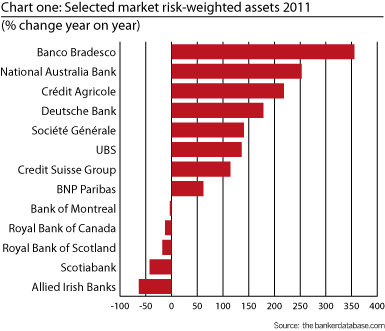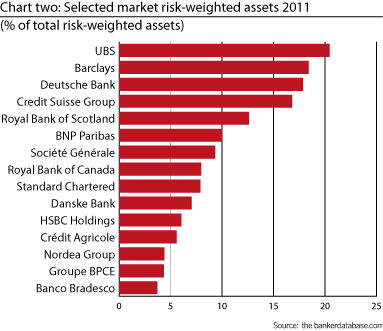The advent of Basel III has already forced banks to change the way they measure market risk, and regulators are set to step up the pressure still further. Find out which banks are most affected.
The Basel Committee on Banking Supervision plans to tighten up how banks hold capital reserves against their securities trading books. A consultative document recently published from Basel called for “a more objective boundary between the trading book and the banking book that materially reduces the scope for regulatory arbitrage”, as well as “comprehensively incorporating the risk of market illiquidity”.
In the wake of the 2008 financial crisis, a number of eurozone banks moved assets from their trading books, where they must be marked to market, onto banking books, which are subject to less volatile cash-flow accounting. This trend may intensify with the onset of Basel III, which assigns a greater weight to market risk when calculating a bank’s capital needs. The fear in Basel is that banks will then hold insufficient capital against potential losses on securities portfolios.
Many of the largest banks are already switching their reporting to Basel III standards, and The Banker's work preparing the 2012 Top 1000 World Banks ranking offers a foretaste of its effects on the measurement of market risk. A selection of banks that have provided The Banker with their end-of-year 2011 accounts show that market risk-weighted assets have in many cases increased dramatically, more than doubling year on year for a number of banks.
The exceptions include banks with a deliberate post-crisis deleveraging strategy, such as Royal Bank of Scotland and Allied Irish Banks. Interestingly, the list of banks where market risk has fallen is dominated by the Canadians, which have long been hailed for their conservative risk management.
However, even with the substantial increases in market risk-weighted assets, credit risk still dominates the portfolios of most banks. UBS has so far shown the highest ratio of market risk to total risk-weighted assets, and this is just over 20%. For Banco Bradesco, market risk-weighted assets more than quadrupled in 2011, but still only total just 3.7% of total risk-weighted assets.
Of course, this partly explains why the Basel Committee is exercised by the distinction between the trading book and the banking book. Assets on the banking book would show up under credit risk instead of market risk, lowering the proportion of market risk-weighted assets. If Basel follows through on its proposal to push more securities holdings back onto trading books, market risk-weighted assets should become a higher proportion of the total for those banks with large capital markets franchises.




